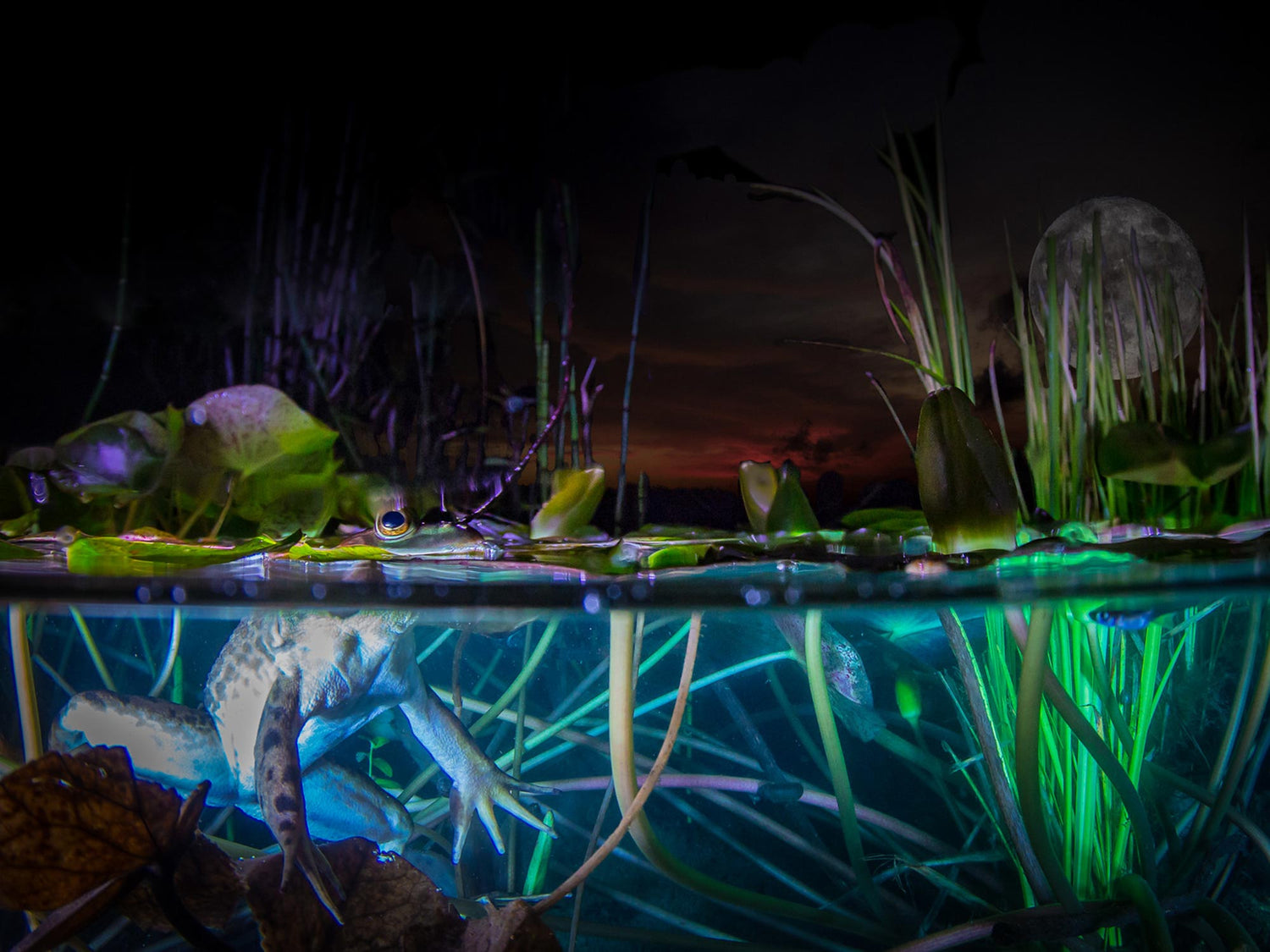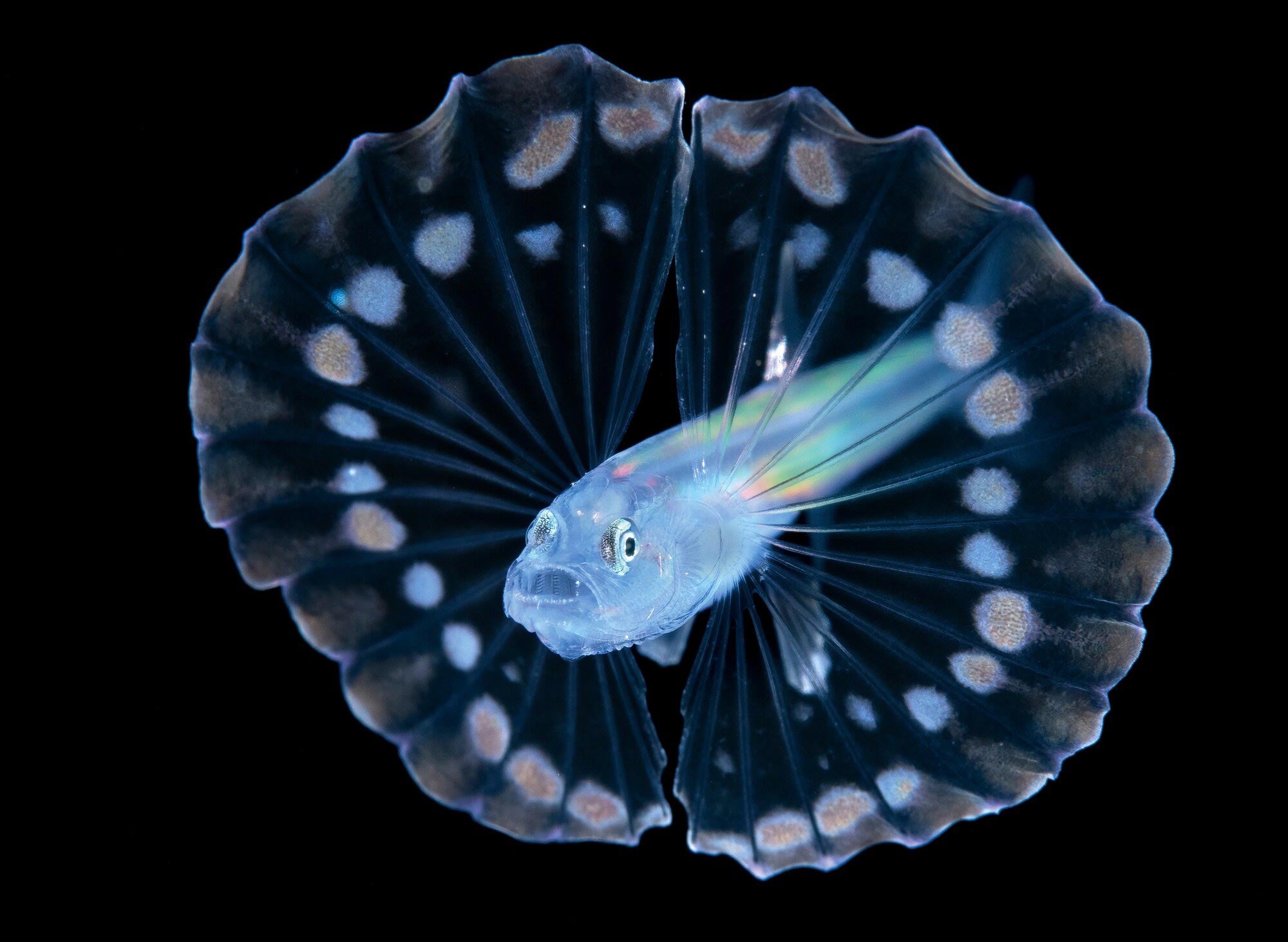Shooting on a night dive is a very different experience. If it's new for you, try starting on a reef that is familiar to you from daytime dives. The first thing you will notice is how much more colorful the reef is at night. We forget that during the day everything is a washed out blue, almost monotone; at night the reds, oranges, and yellows that only your camera sees with flash will be visible to the naked eye. Couple this with the fact that much of the reef is nocturnal, and you may wonder what took you so long to night shoot.

Backlighting is easier to see at night, even a small dive light will create a magnificent glow. © 2022 Steve Miller
Lighting the Way
For flash photographers, particularly macro, the settings do not need to change at all from day to night. If you shoot with a stopped down lens for a black background it can be impossible to tell what time of day the image was captured, although nocturnal creatures will be the telltale sign.
The challenge to shooting at night is how you navigate the reef, find subjects, and rig your system so that you can see where you are going. The simplest, most direct, solution is to mount a powerful light onto your camera housing. You can also mount lights on your strobes and use the built-in modeling lights.
If the light is oriented from the camera housing directly forward like a scope, the camera will be happiest, and focus lock will be very quick. Directing this light from the strobe heads will sometimes be harder for the camera to see and lock focus.

Light arrays in clear water will create enough ambient light to shoot in a place like Hawaii. © 2022 Steve Miller
A Plethora of Plankton
This can have a couple drawbacks though. Specifically, if you use very bright lights constantly on during the dive, and are not moving around much, the bugs will find you. Plankton, including worms that can be 6 inches (15.24cm) long, comes in many sizes, and will collect around your lights. Often predator fish will swim behind photographers lights and ambush subjects. If you hold still long enough there can be enough plankton around to obscure your subjects.

Until the flash goes off, there is very little illumination coming from this setup. © 2022 Steve Miller
Solution: Camouflage with Color
A novel solution is to use colored lights. Specifically red lights are widely used as they seem to upset fish less than white light. Simply subduing your lights with colored gels, and using lower powered lights, can help with navigating the reef while providing enough illumination for your camera to focus.
If you are planning on shooting traditional white strobe light, these colors may show up in your images. To avoid this, some lights will actually turn off briefly when they sense the strobe flashing. You can also angle them away from the scene knowing that your strobe will overpower low powered lights. Mixing colored lights and white light can make your scene a small stage, with colored highlights.
If you like the weird color shifts, called luminance photography, you can accentuate it with dichroic filters for your strobes. At this point you are shooting fluorescence and with the help of yellow glasses, you can look for subjects that are actively fluorescing.

Illuminated by lights with colored filters on them, Crocodilefish eyes will color shift. © 2022 Steve Miller
Night Time is the Right Time
Although night diving may sound disorienting, it's well worth the efforts. You'll be given a front row seat to photograph nocturnal marine life. Fluorescent photography will make for some really unique images. And you may be witness to an entirely new set of animal behaviors than you're used to seeing in the daytime. Stick with your buddy, bring a backup light, and have a former-familiarity with your dive site and you'll want to become nocturnal yourself, just for the photography opportunities.

Lizardfish are well known for always fluorescing. © 2022 Steve Miller
Want the easy way to improve your underwater photography? Sign up for our weekly newsletter for articles and videos directly in your inbox every Friday:
 Ambassador Steve Miller has been a passionate teacher of underwater photography since 1980. In addition to creating aspirational photos as an ambassador, he leads the Ikelite Photo School, conducts equipment testing, contributes content and photography, represents us at dive shows and events, provides one-on-one photo advice to customers, and participates in product research and development. Steve also works as a Guest Experience Manager for the Wakatobi Dive Resort in Indonesia. In his "free" time he busies himself tweaking his very own Backyard Underwater Photo Studio which he's built for testing equipment and techniques. Read more...
Ambassador Steve Miller has been a passionate teacher of underwater photography since 1980. In addition to creating aspirational photos as an ambassador, he leads the Ikelite Photo School, conducts equipment testing, contributes content and photography, represents us at dive shows and events, provides one-on-one photo advice to customers, and participates in product research and development. Steve also works as a Guest Experience Manager for the Wakatobi Dive Resort in Indonesia. In his "free" time he busies himself tweaking his very own Backyard Underwater Photo Studio which he's built for testing equipment and techniques. Read more...
Additional Reading
Fluorescence and Luminance Underwater Photography
3 Ways to Spice Up Your Night Dive
Compositing Underwater Photos with the Full Moon













